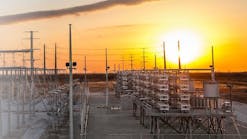As I write this month’s column, the “Bipartisan Infrastructure Deal” has just been passed by Congress and will soon be signed into law by President Joe Biden. The deal’s price tag is about $1.2 trillion and is a major piece of President Biden’s Build Back Better plan. According to the fact sheet released by the White House, the legislation appropriates more than $65 billion to upgrade the electric power infrastructure, making it “the largest investment in clean energy transmission and grid in American history.” The money will be used to build thousands of miles of new transmission lines to carry more clean electricity as additional renewable energy and other clean energy technologies are developed and deployed across the transmission system.
The legislation also provides another $50 billion to make the nation’s infrastructures more resilient against the impacts of climate change, cyberattacks, and extreme weather events. This funding will go toward not only the electric infrastructure, but also water systems, roads, communication systems, government buildings and more. Again, according to the White House brief this will be the largest investment in the resilience of physical and natural systems in American history.
In addition, the deal provides $7.5 billion to build out a national network for EV charging stations. This investment support’s the administration’s goal of creating a network of one-half million EV chargers.
The complete Bipartisan Infrastructure Deal contains much more than this, but these are the three pieces that will likely have the biggest impact on electric utilities and grid owners and operators. This investment is expected to roll out over the next 10 years. By now, you likely have heard or read many opinions on this piece of legislation. For that reason, I will say only that I think the money can be put to good use and I’m pleased that our lawmakers could come to an agreement, pass this legislation, and move it on to the Senate.
I do want to point out, however, that long before this legislation was penned, U.S. electric utilities were already investing billions of dollars in the transmission systems to improve reliability and resiliency, and to accommodate the increases in renewable energy being added to the system. According to a release from the Energy Information Administration (EIA) issued in late March of this year, annual spending on the U.S. transmission system by major U.S. electric utilities increased from $9.1 billion (2019 dollars) in 2000 to $40 billion in 2019. This $40 billion included about $23.5 billion investment in new transmission infrastructure, and $16.6 billion for operations and maintenance of existing transmission systems. The EIA release cites FERC reports that indicate spending on transmission infrastructure leveled off a bit recently, but still rose 3% from 2018 to 2019. The two EIA graphics provide more detail about how and where utilities are investing.
There’s no doubt that an infusion of government money will help prepare the grid for the energy transition. In addition, the heightened public awareness created by this infrastructure deal could help utilities get more support from state utility commissioners, public officials, private sector investors and maybe even customers. The EIA’s findings on grid investment, however, reveal what most of us familiar with the electric power industry already know: Utilities will continue to make investments with or without extra government funding, where and when needed to provide safe, reliable, affordable electricity as we transition to a cleaner and more electrified society.
This month and every month T&D World magazine brings you stories about the technologies and solutions the world’s utilities are developing and implementing to keep pace with the energy transition. I hope you enjoy this month’s stories. Thanks for reading.




